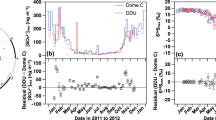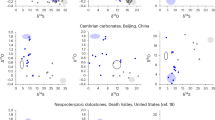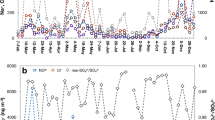Abstract
Dimethylsulphide (DMS), mainly produced by marine biogenic activity, plays an important role in the atmospheric sulphur budget1. Methanesulphonic acid (MSA) and sulphur dioxide (SO2, hereafter converted into non-sea-salt (n.s.s.) sulphate) are the main oxidation products of DMS2. As opposed to n.s.s. sulphate, which has other sources (for example, volcanoes, terrestrial sulphate), MSA represents an unequivocal indicator of marine biogenic activity. MSA has previously been investigated in marine aerosols at low and mid-latitudes3–5 as well as in precipitations and polar ice5,6; here we present 54 MSA measurements made in Antarctic ice. Coastal area precipitations exhibit unexpectedly high (up to 100%) MSA/n.s.s. SO2–4 weight ratios (r) compared with values commonly observed in mid-latitude marine atmospheres3. At higher elevations (2,000 m) the r values suggest a marine biogenic input of more global significance. The MSA concentrations (several p.p.b.) confirm that the n.s.s. sulphate in Antarctic ice is mainly derived from marine biogenic activity. During the last ice age, MSA contents were 2–5 times higher than today. This study of high-latitude precipitations demonstrates the feasibility of reconstructing past marine biogenic activity of global significance.
This is a preview of subscription content, access via your institution
Access options
Subscribe to this journal
Receive 51 print issues and online access
$199.00 per year
only $3.90 per issue
Buy this article
- Purchase on Springer Link
- Instant access to full article PDF
Prices may be subject to local taxes which are calculated during checkout
Similar content being viewed by others
References
1. Andreae, M. O. & Raemdonck, H. Science 221, 744-747 (1983). 2. Grosjean, D. & Lewis, R. Geophys. Res. Lett. 9, 1203-1206 (1982). 3. Saltzman, E. S., Savoie, D. L., Zika, R. G. & Prospero, J. M. /. geophys. Res. 88,10897-10902 (1983). 4. Saltzman, E. S., Savoie, D. L., Prospero, J. M. & Zika, R. G. Geophys. Res. Lett. 12,437-440 (1985). 5. Ayers, G. P., Ivey, J. P. & Goodman, H. S. / Atmos. Chem. 4, 173-185 (1986). 6. Ivey, J. P., Davies, D. M., Morgan, V. & Ayers, G. P. Tellus 38B, 375-379 (1986). 7. Legrand, M., De Angelis, M. & Delmas, R. J. Analyt. chim. Acta 156, 181-182 (1984). 8. Legrand, M. & Saigne, C. Atmos. Envir. (submitted). 9. Saigne, C., Kirchner, S. & Legrand, M. Analyt. chim. Acta (in the press). 10. Legrand, M. these d'etat, Univ. Scientifique et Medicate de Grenoble (France) Laboratorie de Glaciologie du CNRS (1985). 11. Clegg, S. L. & Brimblecombe, P. Envir. Tech. Lett. 6, 269-278 (1985). 12. Atkinson R., Pitts, J. N. Jr. & Aschmann, S. M. /. phys. Chem. 88, 1584-1587 (1984). 13. Hatakeyama, S., Izumi, K. & Akimoto, H. Atmos. Envir. 19, 135-141 (1985). 14. Cunningham, W. C. & Zoller, W. H. J. Aerosol Sci. 12, 367-384 (1981). 15. Petit, J. R., Briat, M. & Royer, A. Nature 293, 391-394 (1981). 16. Palais, J. & Legrand, M. J. Geophys. Res. 90, 1143-1154 (1985). 17. Raynaud, D., Lorius, C., Budd, W. F. & Young, N. W. J. Glaciol. 24, 103-114 (1979). 18. Lorius, C., Merlivat, L., Jouzel, J. & Pourchet, M. Nature 280, 644-648 (1979). 19. Sarthein, M., Winn, K. & Zahn, R. Abrupt Climatic Changes: Evidence and Implications (eds Berger, W. H. & Labeyrie) (Reidel, Dordrecht, in the press).
Author information
Authors and Affiliations
Rights and permissions
About this article
Cite this article
Saigne, C., Legrand, M. Measurements of methanesulphonic acid in Antarctic ice. Nature 330, 240–242 (1987). https://doi.org/10.1038/330240a0
Received:
Accepted:
Issue Date:
DOI: https://doi.org/10.1038/330240a0
Comments
By submitting a comment you agree to abide by our Terms and Community Guidelines. If you find something abusive or that does not comply with our terms or guidelines please flag it as inappropriate.



